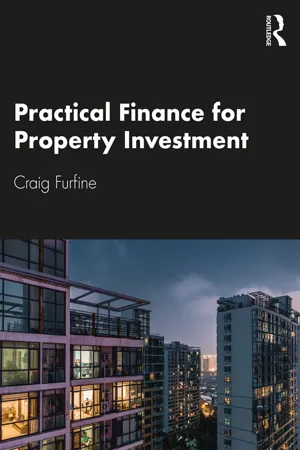
- 166 pages
- English
- ePUB (mobile friendly)
- Available on iOS & Android
Practical Finance for Property Investment
About this book
Practical Finance for Property Investment provides readers with an introduction to the most fundamental concepts, principles, analytical methods, and tools useful for making investing and financing decisions regarding income-producing property. The book begins by considering how to value income-producing property by forecasting a property's cash flows and estimating appropriate discount rates. It then discusses how both debt and private equity are used as methods to finance a property's acquisition. The book provides a thorough discussion of the taxation of property income as well as how investors can quantify the risks to investing in property. The book concludes with important considerations for investors when their investment thesis does not come to fruition.
Practical Finance for Property Investment offers a unique and novel pedagogy by pairing each book chapter with an in-depth real-world case study, which forces readers to confront the occasional tensions between finance theory and property investment practice. The book is designed for investors and students interested in learning what finance theory implies about property investment.
Readers and Instructors can access electronic resources, including the spreadsheets used in the textbook, at the book's website: www.routledge.com/9780367333041.
Frequently asked questions
- Essential is ideal for learners and professionals who enjoy exploring a wide range of subjects. Access the Essential Library with 800,000+ trusted titles and best-sellers across business, personal growth, and the humanities. Includes unlimited reading time and Standard Read Aloud voice.
- Complete: Perfect for advanced learners and researchers needing full, unrestricted access. Unlock 1.4M+ books across hundreds of subjects, including academic and specialized titles. The Complete Plan also includes advanced features like Premium Read Aloud and Research Assistant.
Please note we cannot support devices running on iOS 13 and Android 7 or earlier. Learn more about using the app.
1 Leasing
Introduction
Overview of lease features
- 1 The space
- 2 The term
- 3 The rent
- 4 Expense sharing
- 5 Concessions
- 6 Options
The space
The term
The rent
Quotation
Table of contents
- Cover
- Half Title
- Title
- Copyright
- Dedication
- Contents
- Acknowledgements
- 1 Leasing
- 2 Property valuation
- 3 Debt financing
- 4 Equity partnerships
- 5 The taxation of property investment
- 6 The quantification of risk
- 7 When things go wrong
- Index